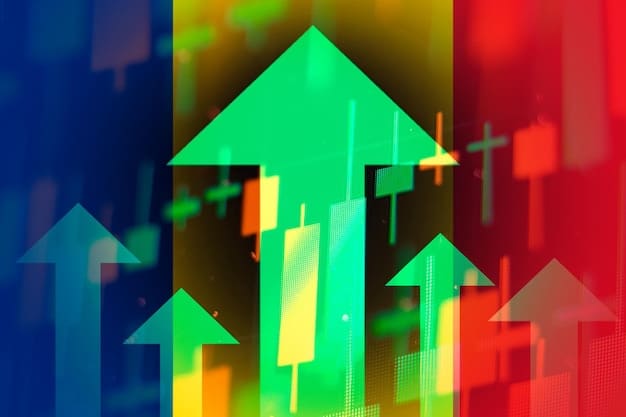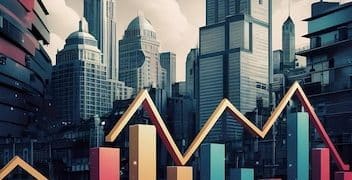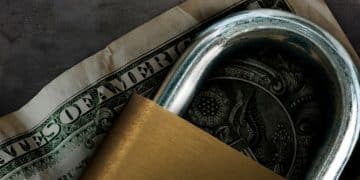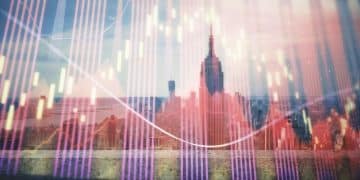Fed Rate Hike: Jan 0.5% Increase & Business Impact Analysis

The Federal Reserve’s recent signal of a potential 0.5% interest rate hike in January could significantly impact businesses, leading to higher borrowing costs, reduced investment, and slower consumer spending, necessitating strategic adaptations across various sectors to mitigate adverse effects.
In a dynamic global economy, businesses constantly navigate a landscape shaped by monetary policy. A recent announcement from the Federal Reserve hinting at a substantial 0.5% interest rate hike in January has sent ripples across financial markets and boardrooms alike. This potential shift signals a more aggressive stance from the central bank, aiming to curb inflation, but it also carries significant implications for operational costs, investment strategies, and consumer behavior. Understanding the multifaceted impact of such a move is crucial for companies to prepare and adapt in an evolving economic climate.
Understanding the Federal Reserve’s Stance and Objectives
The Federal Reserve, often referred to simply as “the Fed,” operates as the central banking system of the United States. Its primary mandates are to foster maximum employment and maintain price stability. These often appear to be conflicting objectives, especially in an inflationary environment. When the economy runs hot, with demand outstripping supply, prices tend to rise, eroding purchasing power. This is where interest rate adjustments become one of the Fed’s most potent tools.
Interest rates are the cost of borrowing money. By raising these rates, the Fed makes it more expensive for banks to borrow from it, which in turn leads banks to charge higher rates for loans to businesses and consumers. The ultimate goal is to cool down an overheated economy by discouraging borrowing and spending, thereby reducing aggregate demand and, consequently, inflation. The recent signal of a 0.5% interest rate hike is a clear indication that the Fed perceives inflation as a persistent and significant threat, warranting a more forceful intervention than previously adopted.
The Rationale Behind Aggressive Hikes
Historically, the Fed prefers incremental adjustments, typically 0.25%. A 0.5% hike, often dubbed a “double hike,” signals an urgency and a determination to get inflation under control quickly. Several factors contribute to this aggressive posture:
- Persistent Inflationary Pressures: Despite earlier predictions that inflation would be “transitory,” it has proven to be more stubborn, driven by supply chain disruptions, strong consumer demand, and geopolitical events.
- Wage-Price Spiral Concerns: There are fears of a wage-price spiral, where rising wages lead to higher costs for businesses, which in turn raise prices, prompting demand for even higher wages.
- Maintaining Credibility: The Fed needs to demonstrate its commitment to its price stability mandate to maintain public and market confidence in the long-term value of the dollar.
The decision to telegraph such a significant hike ahead of time also serves a purpose: it allows markets and businesses to begin adjusting expectations and planning accordingly. This forward guidance aims to prevent disruptive surprises while still signaling a firm hand on the economic tiller. However, even with advance notice, the implications for various sectors of the economy remain substantial and complex, requiring careful analysis and proactive measures from businesses.
In essence, the Fed is walking a tightrope, attempting to cool the economy enough to bring inflation down without plunging it into a recession. The 0.5% rise reflects a calibrated risk taken to restore economic equilibrium, but its ramifications will be felt broadly, influencing everything from corporate financial decisions to everyday consumer behavior. Businesses must be acutely aware of these dynamics and prepare for a potentially more restrictive credit environment.
Impact on Borrowing Costs and Capital Expenditure
One of the most immediate and direct consequences of an interest rate hike, particularly one of 0.5%, is the increase in borrowing costs for businesses. Companies, irrespective of their size, rely on various forms of credit for their operations, expansions, and working capital needs. Whether it’s a small business seeking a line of credit or a large corporation issuing bonds, the cost of that capital is intrinsically linked to prevailing interest rates.
When the Federal Reserve raises its benchmark rate, commercial banks typically follow suit, increasing the interest rates they charge their customers. This means that new loans, as well as existing variable-rate loans, will become more expensive. For businesses, this translates to higher interest payments, directly impacting their profitability and cash flow. Companies with significant variable-rate debt could see a noticeable strain on their finances almost immediately.
Re-evaluating Investment Strategies
The cost of capital plays a pivotal role in a company’s decision-making regarding capital expenditure (CapEx). CapEx refers to funds used by a company to acquire, upgrade, and maintain physical assets such as property, industrial buildings, or equipment. These investments are crucial for long-term growth, increased productivity, and competitive advantage. However, when borrowing costs rise, the economic viability of these projects can diminish.
Consider a scenario where a business plans to purchase new machinery. If the interest rate on the loan for this machinery increases, the total cost of the acquisition over time rises significantly. This increased cost has a direct negative effect on the projected return on investment (ROI) for that particular CapEx. Projects that were marginally profitable at lower interest rates might become unprofitable at higher rates, leading businesses to postpone or outright cancel planned investments.
- Delayed Expansion Plans: Businesses might delay opening new branches or expanding production lines.
- Reduced R&D Spending: Investment in research and development, which often requires significant upfront capital, could be curtailed.
- Stricter Project Scrutiny: Companies will apply more rigorous financial checks to new projects, favoring only those with very high potential returns.
- Focus on Debt Reduction: Some businesses might prioritize using available cash to pay down existing debt rather than investing in new ventures.
This slowdown in CapEx can have broader economic implications, affecting industries that supply capital goods and potentially leading to a deceleration in overall economic growth. Businesses might also find it harder to refinance existing debt at favorable terms, potentially locking them into higher rates for longer periods. Navigating this environment requires prudent financial management, a detailed review of debt portfolios, and a re-evaluation of all future capital allocation decisions to ensure financial stability and sustainable growth.

Impact on Consumer Spending and Demand
The Federal Reserve’s actions, particularly significant interest rate hikes, exert a profound influence not just on businesses’ borrowing costs, but also on the broader economy’s lifeblood: consumer spending. Consumers represent a vast portion of aggregate demand, and their willingness and ability to spend are directly tied to economic conditions. When interest rates rise, several mechanisms come into play that can temper this spending, ultimately impacting businesses that rely heavily on consumer demand.
Firstly, higher interest rates make borrowing more expensive for individuals. This includes mortgages, car loans, credit card debt, and personal loans. For instance, a rise in mortgage rates can significantly increase monthly payments for new homeowners or those with variable-rate mortgages, leaving less discretionary income for other goods and services. Similarly, car purchases might be postponed, or consumers might opt for cheaper models, as loan payments become more burdensome. This direct increase in the cost of consumer credit tightens household budgets.
Shifts in Consumer Behavior
Beyond the direct financial pressure, rising interest rates can also influence consumer psychology. When the cost of living increases due to inflation, and borrowing becomes more expensive, consumers tend to become more cautious. This often leads to a shift in spending patterns:
- Reduced Discretionary Spending: Consumers are likely to cut back on non-essential items, such as dining out, entertainment, luxury goods, and travel. Businesses in these sectors will feel the pinch most acutely.
- Increased Savings: Higher interest rates on savings accounts and certificates of deposit (CDs) might incentivize consumers to save more and spend less, viewing saving as a more attractive option than immediate consumption.
- Preference for Essentials: Spending will likely prioritize necessities like groceries, utilities, and healthcare, with discretionary purchases being deferred.
- Impact on Larger Purchases: Big-ticket items that often require financing, such as homes and vehicles, will see significant impact due to higher loan servicing costs.
For businesses, this translates to potentially lower sales volumes and slower revenue growth. Companies in retail, automotive, real estate, and hospitality sectors are particularly vulnerable. Even businesses in less consumer-facing sectors can feel secondary effects as their B2B clients experience reduced demand from their consumer base. Businesses might need to adjust their pricing strategies, marketing efforts, and inventory levels to align with a more conservative consumer environment. Understanding this direct link between monetary policy, consumer behavior, and sales is critical for businesses to forecast demand accurately and adapt their operations accordingly.
The overall objective of the Fed’s rate hike – to reduce aggregate demand to combat inflation – will inevitably spill over into consumer behavior, creating a more challenging sales environment for many businesses. Strategic responses will include potentially offering more attractive financing terms (though this becomes harder with higher internal costs), focusing on value propositions, or exploring new markets.
Impact on Specific Sectors and Industries
While interest rate hikes have a broad economic impact, their effects are not uniformly distributed across all sectors. Certain industries are inherently more sensitive to changes in borrowing costs and consumer spending patterns than others. Understanding these sector-specific vulnerabilities is crucial for businesses to assess their individual risk exposure and formulate targeted mitigation strategies.
Real Estate and Construction: This sector is arguably one of the most sensitive to interest rate fluctuations. Higher mortgage rates dampen housing demand, making homeownership less affordable for many. This can lead to a slowdown in home sales, reduced construction activity, and potentially falling property values. Developers face increased costs for construction loans, which can delay or halt new projects. Businesses supplying materials or services to this industry will also feel the ripple effect.
Automotive Industry: Car purchases are frequently financed, and rising interest rates make auto loans more expensive. This can deter consumers from buying new vehicles or push them towards cheaper alternatives or used cars. Dealerships and manufacturers might experience a decline in sales volume, necessitating incentives or adjustments to production schedules.
Technology and High-Growth Sectors
The technology sector, particularly startups and companies focused on high growth, can be significantly affected. These businesses often rely on venture capital, angel investment, or debt financing to fund their rapid expansion, which may involve significant upfront investment with delayed returns. When interest rates rise, capital becomes more expensive, impacting valuations and the attractiveness of future-oriented, non-profitable ventures. Investors may demand higher returns to compensate for the increased cost of capital, making it harder for companies to raise funds.
- Reduced Investment Rounds: Fewer and smaller venture capital rounds as investors become more risk-averse.
- Pressure on Profitability: Startups may face increased pressure to achieve profitability sooner, rather than prioritizing growth at all costs.
- Hiring Freezes: Companies may slow down or freeze hiring to conserve cash.
- Valuation Adjustments: Public tech companies, especially those not yet profitable, can see their stock prices decline as future earnings are discounted more heavily.
Retail and Consumer Discretionary: As discussed, reduced consumer spending directly affects retailers, particularly those selling non-essential goods. Businesses offering luxury items, high-end electronics, or specialized services might see a sharper decline in sales compared to essential goods providers. They may need to innovate on pricing, product offerings, or customer experience to maintain market share.
Financial Services: While banks might initially benefit from higher net interest margins (the difference between what they earn on loans and pay on deposits), rising rates also increase the risk of loan defaults. Investment banks and asset managers could see reduced transaction volumes if deal-making slows down due to higher financing costs.
Small and Medium-sized Enterprises (SMEs): SMEs often have less access to diverse funding sources and may be more reliant on traditional bank loans. Higher interest rates can disproportionately affect their ability to secure financing for growth or even for maintaining operations, making them particularly vulnerable to economic contractions. They might also have less pricing power to pass on increased costs to consumers.
In essence, businesses across all sectors must meticulously analyze their financial structures, customer bases, and operational dependencies to understand how the ripples of an interest rate hike might specifically impact their niche. Proactive scenario planning and agile strategic adjustments will be paramount for resilience.
Mitigating Risks and Strategic Business Responses
In the face of potential interest rate hikes, businesses are not without recourse. Proactive planning and strategic adjustments can significantly mitigate the adverse effects and even uncover new opportunities. The key lies in understanding one’s specific vulnerabilities and developing a diversified, agile response.
Review and Restructure Debt: One of the first steps should be a thorough review of existing debt. Businesses with significant variable-rate loans should consider converting them to fixed-rate options if current rates are still favorable, thereby locking in predictable payments and avoiding future increases. For new borrowing, exploring different financing structures and negotiating terms diligently with lenders becomes even more critical. Prioritizing debt reduction to lessen interest burdens is also a prudent move for companies with strong cash flow.
Optimize Cash Flow and Working Capital: Efficient management of cash flow is paramount. This involves optimizing accounts receivable and payable cycles, reducing inventory where possible to free up capital, and closely monitoring all operational expenses. Building a robust cash reserve provides a buffer against unexpected increases in costs or a downturn in revenues, reducing reliance on external financing.
Enhancing Operational Efficiency and Cost Control
When revenues are under pressure due to dampened demand and costs of borrowing are rising, a strong focus on operational efficiency becomes imperative. This means scrutinizing every aspect of the business for potential cost savings without compromising quality or essential services.
- Streamlining Processes: Identifying and eliminating bottlenecks or redundant processes can reduce operational costs and improve productivity. Implementing automation where feasible can lead to long-term savings.
- Negotiating with Suppliers: Re-evaluating supplier contracts and negotiating better terms or exploring alternative, more cost-effective suppliers can yield significant savings.
- Energy Efficiency: Investing in energy-efficient equipment or practices can lower utility bills, providing ongoing cost reductions.
- Employee Training/Retention: While cutting labor costs might seem appealing, investing in training to upskill current employees can improve efficiency and reduce the costs associated with high employee turnover.
Diversification and Innovation: Businesses should explore diversifying their revenue streams, product offerings, or geographic markets to reduce reliance on any single area. Innovation, whether in products, services, or business models, can create unique value propositions that are less sensitive to economic fluctuations. For example, focusing on a strong unique selling proposition (USP) can help maintain demand even in a cautious consumer environment.
Strong Customer Relationship Management: In times of reduced consumer spending, retaining existing customers becomes even more vital. Investing in customer relationship management (CRM) strategies, enhancing customer service, and building loyalty programs can reduce customer churn and ensure a more stable revenue base.
Ultimately, a holistic approach that combines financial prudence, operational excellence, and strategic foresight will enable businesses to navigate the challenges posed by rising interest rates and position themselves for long-term resilience and growth.

Long-Term Economic Outlook and Future Considerations
The Federal Reserve’s decision to potentially implement a 0.5% interest rate hike in January is not an isolated event but rather a piece of a larger mosaic influencing the long-term economic outlook. Monetary policy changes often have lagged effects, meaning their full impact might not be felt for several months or even quarters. Understanding these broader implications is vital for businesses to formulate sustainable long-term strategies, rather than just reacting to immediate changes.
Inflationary Trajectory: The primary objective of interest rate hikes is to bring inflation under control. The ultimate success of this strategy will define the economic landscape for years to come. If inflation moderates, the Fed may ease its aggressive stance, potentially leading to a more stable interest rate environment. However, if inflation proves more pernicious, further hikes might be necessary, prolonging the period of higher borrowing costs and potentially slower economic growth.
Risk of Recession: A significant concern for many economists and businesses is the potential for a “hard landing” – where aggressive rate hikes push the economy into a recession. While the Fed aims for a “soft landing” (cooling inflation without triggering a downturn), the path is narrow. A recession would lead to reduced economic activity, higher unemployment, and widespread business challenges, even beyond the direct impact of interest rates. Businesses should engage in scenario planning for various economic outcomes, including mild or severe recessions.
Adapting to a New Normal in Finance
The current period of rising rates marks a significant departure from the ultra-low interest rate environment that prevailed for over a decade following the 2008 financial crisis. Businesses that grew up or expanded significantly during that era might need to fundamentally rethink their financial models and risk appetites. This isn’t just a temporary blip; it could be a shift towards a new normal where capital is no longer as cheap or abundant.
- Higher Cost of Equity: Investor expectations for returns might adjust upwards, making it harder for companies to attract equity investment unless they demonstrate strong profitability or clear growth trajectories.
- Reshaping Investment Decisions: Projects requiring long-term capital with distant payoffs will be scrutinized more heavily. Emphasis might shift towards quicker returns and more conservative financial structures.
- Increased Importance of Balance Sheet Health: Companies with strong balance sheets, low debt, and healthy cash reserves will be better positioned to weather economic storms and seize opportunities.
- Global Economic Interdependencies: US interest rate hikes can strengthen the dollar, making US exports more expensive and imports cheaper. This impacts multinational corporations and those engaged in international trade, requiring adjustments to pricing and supply chain strategies.
Innovation and Productivity: In a higher cost environment, the drive for innovation and productivity improvements becomes even more critical. Businesses that can find ways to produce more efficiently, leverage technology, and create new value will be better equipped to thrive. This could spur investment in automation, AI, and other technologies that enhance output per unit of input.
The long-term outlook is inherently uncertain, but key trends suggest a period where fiscal discipline, operational efficiency, and strategic adaptability will be prized above all else. Businesses that recognize this shift and proactively adjust their strategies will be better prepared to navigate the complexities of the evolving economic landscape and emerge stronger in the long run.
Conclusion: Navigating the New Economic Reality
The Federal Reserve’s signal of a potential 0.5% interest rate hike in January marks a pivotal moment in the current economic cycle. This aggressive move, aimed at cooling persistent inflation, will inevitably usher in a period of higher borrowing costs, a more cautious consumer, and a re-evaluation of investment priorities across all sectors. For businesses, this is not merely a financial adjustment but a fundamental shift in the operating environment that demands strategic foresight and agile responses.
The direct impact on borrowing costs will necessitate a rigorous assessment of debt portfolios and capital expenditure plans. Companies must focus on enhancing cash flow, optimizing working capital, and scrutinizing every operational expense to maintain profitability. Meanwhile, changes in consumer spending patterns will require businesses to adapt marketing, sales, and inventory strategies, particularly in discretionary sectors. Industries like real estate, automotive, and high-growth technology will face distinct challenges, requiring tailored approaches.
Looking ahead, businesses must not only mitigate immediate risks but also prepare for a potentially prolonged period of higher interest rates the “new normal” in the financial landscape. This calls for stronger balance sheets, a relentless pursuit of operational efficiency, and a renewed emphasis on innovation and diversification. While the path may be challenging, those companies that embrace strategic planning, prioritize resilience, and foster adaptability will be best positioned to navigate these economic headwinds and emerge stronger in the long term, contributing to a more stable and sustainable economy.
| Key Metric | Brief Impact |
|---|---|
| 📈 Borrowing Costs | Directly increases loan interest rates for businesses, impacting profitability. |
| 📉 Capital Expenditure | Higher costs reduce viability of new investments; projects may be delayed. |
| 🛍️ Consumer Spending | Loan costs rise for consumers, leading to reduced discretionary spending. |
| 🛡️ Strategic Adaptation | Businesses must review debt, optimize cash flow, and enhance operational efficiency. |
Frequently Asked Questions
▼
The Federal Reserve is considering a 0.5% hike to combat persistent and elevated inflation. This more aggressive stance aims to cool down an overheated economy by making borrowing more expensive, which discourages spending and investment, thereby reducing overall demand and stabilizing prices. It also helps reinforce the Fed’s commitment to its price stability mandate, maintaining market confidence.
▼
A 0.5% hike means that commercial banks will likely increase their prime rates, leading to higher interest rates on both new and existing variable-rate loans for businesses. This directly translates to increased interest payments on debt, impacting cash flow and reducing overall profitability. It makes financing for new projects more expensive, raising the hurdle for return on investment.
▼
Sectors highly dependent on borrowing or consumer discretionary spending are most vulnerable. This includes real estate and construction, where higher mortgage rates deter buyers; the automotive industry, due to more expensive car loans; and technology/high-growth companies, which often rely on debt or venture capital for expansion. Retail and hospitality also face challenges from reduced consumer spending.
▼
Businesses can mitigate risks by reviewing and potentially restructuring debt, opting for fixed-rate loans where possible. They should optimize cash flow, reduce working capital needs, and implement stringent cost control measures. Enhancing operational efficiency, diversifying revenue streams, and maintaining strong customer relationships are also crucial strategies to navigate a higher interest rate environment effectively.
▼
While the Fed aims for a “soft landing,” there’s an inherent risk that aggressive rate hikes could tip the economy into a recession. Businesses should prepare by strengthening their balance sheets, building cash reserves, and engaging in scenario planning for various economic outcomes. Prioritizing profitability over sheer growth, and focusing on essential services or products, can enhance resilience during downturns.





